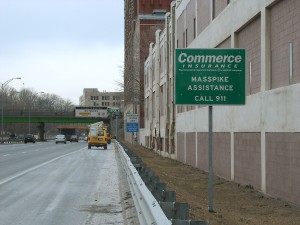Headlights On . . . Luisa Paiewonsky
 Company: Massachusetts Department of Transportation
Company: Massachusetts Department of Transportation
Department: Highway Division
Position/Title: Highway Administrator
Please describe your early aspirations/ career goals that led to your current role as Highway Division Administrator?
I have been interested in highways since childhood. I grew up in Fitchburg, and Route 2 was (and is) my favorite road. After college internships in the state highway department and a three year tour in the U.S. Peace Corps, I decided to pursue a career in public service. I returned to the highway department in 1989 and have been here ever since. Safety has long been one of my strongest professional interests, and my very first directive as Commissioner was to require the use of personal protective equipment by all of our employees. As I often tell our employees, safety begins with each one of us, and we have spent a lot of resources and effort to ensure that our field employees are well-trained, highly visible, protected and safe.
Improvements to highway safety are among your greatest accomplishments. What are some of your other major accomplishments?
I am indeed very proud of our organization’s record on safety, including worker safety. But we have also made great strides in improving the physical condition of our roads and bridges – our Interstate pavement conditions are ranked first in the nation, and we have reduced structurally deficient bridges by more than 10% in the past two years. These actually reflect a number of factors – the Governor’s $3 billion Accelerated Bridge Program, the hiring of additional engineering and other professional staff, streamlining our design and construction activities, and introducing performance measures in key areas. The size of our annual Statewide Road and Bridge construction program has doubled to $1.1 billion, and it is important for our public credibility that the condition of the state’s highway infrastructure reflect that level of investment.
You are one of the longest serving Administrators in the history of the Commonwealth working under two governors of different parties. Do you think that with your appointment the position was returned to one of professional management from one of politics/ management? Please explain.
As a career professional, I feel very fortunate to have been given the opportunity to lead the organization for this long. I do think that the public views highways and bridges largely as essential government responsibilities and not necessarily as partisan issues. Whatever their political beliefs, people expect us to do our jobs with competence and commitment. As a state agency, we are responsible for carrying out the Governor’s transportation policies and agenda. At a more basic level, citizens count on us to plow the roads, fill potholes, inspect and repair bridges and respond to emergencies around the clock, every day of the year. Our fundamental mission is safety, and that is a priority embraced across the political spectrum.
With the recent merger and reorganization of the Massachusetts transportation agencies into MassDOT, what have been the benefits and challenges for the new Highway Division?
The biggest challenge has been merging the cultures and practices of four separate highway organizations with four distinct sets of cultures, practices and mindsets. But there is an unprecedented opportunity to blend the best practices of each organization and try to build a cohesive whole. The Turnpike Authority excelled in operations in maintenance; MassHighway had outstanding design and construction capability; the Massport Tobin Bridge staff specialized in bridge management; the Department of Conservation and Recreation brought advanced public outreach and environmental stewardship experience to MassDOT. Blending these attributes gives us the chance to create one of the best highway organizations in the country, consistent with MassDOT’s goals of becoming a national model of transportation excellence.
What challenges do you face as a woman in a largely male dominated field? Do barriers still remain for women in the field?
When I began my career, Jane Garvey was serving as the Agency’s first woman Commissioner, and there were several women Associate Commissioners. But overall there were very few women holding management, technical or engineering positions, and it was very noticeable. I was helped enormously by joining the Women’s Transportation Seminar (WTS-Boston), a professional networking organization for women in transportation, and I always recommend that young employees join professional networks and trade associations to advance their careers and develop leadership skills.
Today at MassDOT, the atmosphere is much different from when I started out. Now women hold key positions in many different disciplines, including engineering, operations and construction. I think we benefit by having an organizational culture that values productivity and teamwork, and that keeps us focused on the right things. We have worked closely with organizations such WTS-Boston and MassGAP to recruit qualified women candidates and that has been very helpful. We still have a long way to go in recruiting a more diverse workforce – women make up only about 15% of our employees. But it is a far better environment now than it was when I started and it is going in the right direction.
 Massachusetts was one of the first states in the nation to implement a Safety Service Patrol Program and to forge one of the first public- private partnerships with the Consumer Value Stores (CVS). Twenty-five years later, Mass Highway again led the nation with the implementation of a new public/private model whereby the state operates a privately supported program through sponsorship. What are your views on this business model?
Massachusetts was one of the first states in the nation to implement a Safety Service Patrol Program and to forge one of the first public- private partnerships with the Consumer Value Stores (CVS). Twenty-five years later, Mass Highway again led the nation with the implementation of a new public/private model whereby the state operates a privately supported program through sponsorship. What are your views on this business model?
I like this model because it capitalizes on the respective strengths of the private and public sector partners. We have intimate knowledge of the highways, including the congestion points, the appropriate response to various operational situations, and our private sector partners have the resources and expertise to staff and support the program and communicate its goals to the public. It is a mutually beneficial partnership and we are certainly committed to continuing it and perhaps expanding it to other areas.
With the development of new technologies and pressing economic conditions, how does the Highway Assist program continue to meet the safety needs of motorists?
The past twenty years have brought great advances in technology as well as more recent budget constraints. But we believe that the Highway Assist program remains a cost- effective tool for improving safety and reducing congestion. Even with the ability to use pavement sensors, video technology and advanced communication devices, it is still important to have real people patrolling the roads and using their best judgment to respond to emergencies, incidents, disabled vehicles and crashes. When you think about how expensive road closures and restrictions can be in terms of lost productivity and driver delay, and add in the safety costs from secondary crashes, it really becomes clear that using a variety of tools, including highway patrols, is a very efficient method of managing our highways.
What types of changes and improvements have you made to the Commerce Insurance Highway Assist program over the years to ensure safety remains the first priority on Massachusetts’ highways?
The fundamental model of patrolling the major highways and providing immediate assistance to disabled vehicles has remained unchanged. But we have made improvements in response to our experiences in the first few years. We increased funding of the program to incorporate three additional routes, increasing the program from 22 to 25 routes. We require the van drivers to wear safety vests and hard hats at all times when outside the vehicle. We make sure that drivers approach vehicles on the passenger side, rather than the driver side to keep them away from an active lane of traffic. We require all drivers to carry photo identification badges that clearly identify them as working for MassDOT, to ensure that drivers are not alarmed by someone approaching their vehicle.
Please share a tale of a driver that went “above and beyond the call of duty.”
I really can’t name just one since there are so many, but I can say that the most heartfelt and grateful correspondence I receive is about the CARES Vans. Many assisted drivers have sent in money and wanted to give the money back to the program (we send it back, with our thanks). There are some letters from assisted drivers that stand out in my mind:
“Best use of my tax dollars.”
“He was so kind and helpful. Did a wonderful job. He was perfect. Especially in my time of need.”
“Anthony saved me! I couldn’t get in touch with any tow trucks, and thankfully he came along to give me gas. He was amazing.”
And two grateful drivers sent marriage proposals to one of our van patrol operators.
Public agencies don’t often receive this kind of feedback from citizens, so we are happy to hear from those who were assisted by our van patrols.
What type of training do Massachusetts Highway Assist drivers undergo?
All drivers attend a training class twice a year. There is a standard operating procedure manual from which all drivers are trained. All drivers are taken on a comprehensive tour of the HOC so they can understand who they are speaking with on a daily basis when reporting to the HOC. MassDOT does regular checklist inspections of all vehicles to ensure that drivers are properly outfitted and that their vehicles are carrying all the required equipment.
How do you envision the program will change over the next decade?
The fundamental model of patrolling the major highways and providing immediate assistance to disabled vehicles has remained unchanged. But we have made improvements in response to our experiences in the first few years. We increased funding of the program to incorporate three additional routes, increasing the program from 22 to 25 routes.
The creation of the MassDOT Highway Division itself will propel changes in the program. Both the Massachusetts Highway Department and the Massachusetts Turnpike Authority had highway patrol vans sponsored by Commerce Insurance, but were operated differently. On I-90, the drivers were Turnpike employees in Turnpike vehicles. The MassHighway program used private contractors to drive patrols on the major highways. Those contracts for the Highway Assistance Program end in early 2012. We are now looking into how the two programs will be merged together. We have already consolidated the management of programs under our Deputy Chief Engineer for Operations and Maintenance. In the coming year, I envision these two programs being fully integrated with more MassDOT personnel and equipment performing the work.
Additional Comments:
Just a reminder to drivers that as the days get shorter and darker, it is more important than ever to wear seat belts, and ensure that your passengers do too.
